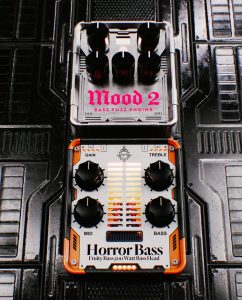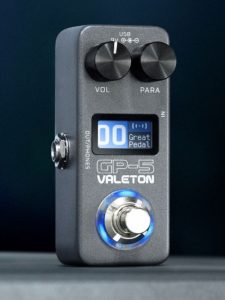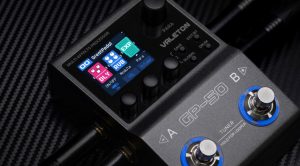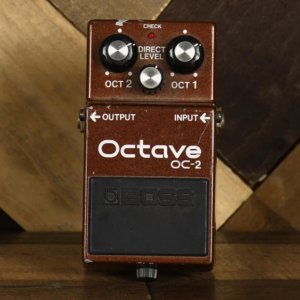We take a first look at MXR new release.
The announcement of the MXR Bass Synth on July 1, 2025, created an instant buzz among low-end explorers, and after several days of hands-on testing, it’s clear why. Co-designed with bassist and educator Ian Martin Allison, the MB301 aims to occupy the sweet spot between plug-and-play simplicity and deep sonic tinkering. Here’s how it fares once the honeymoon period is over.

Design, Build and Power
From the first look, the MB301 feels unmistakably MXR: a compact, weighty aluminium chassis that will survive life on a busy pedalboard. Six large, evenly spaced knobs sit up front, flanked by two soft-touch mini buttons (Voice and Shape) and an illuminated Presets switch. Around back, a mono input, TRS output (for stereo or wet/dry operation), and a multi-purpose CTR jack (expression, tap-tempo or right-channel out) keep routing options flexible. Power is via a 9V DC, 330 mA centre-negative supply—no battery option, which makes sense given the current draw.
Control Layout and Everyday Workflow
At surface level, the pedal is blissfully immediate: Mix balances dry and synth, Sub Mix blends a dedicated sub-oscillator, Cutoff and Resonance form a classic four-pole low-pass filter, while Envelope and Mod govern dynamics and movement. Beneath these are 13 secondary parameters (compression, glide, tracking mode, gate sensitivity, output gain, and more) accessed by holding Voice or Shape while turning the knobs. Everything—even those deeper tweaks—can be stored in eight on-board presets, recalled by a long-press of the footswitch.
Preset Suite: A Guided Tour of Classic Lines
The factory sounds are more than throwaways: Thrillenganes, Wonderful, Lizard Synth, Synthadelic, Sledge, and Army of Synth emulate the signature timbres of Greg Phillinganes (Thriller), Stevie Wonder, Herbie Hancock, Bernie Worrell, Tony Levin, and Björk respectively. Each patch demonstrates a different corner of the engine—sub-octave punch, resonant quack, slow-sweep pads—and they’re ideal jumping-off points for your own edits.
Tone and Performance
Tracking and latency: On a standard four-string tuned to E♭, the synth locks on confidently down to open E. Switching tracking mode to “5-String Bass” extends the range to low B with only the occasional wobble on slides. Glide can be set from snappy note-on phrases to syrupy portamento—great for Daft Punk-style slides.
Filter character: The Cutoff/Resonance pair feels lifted straight from a classic analogue monosynth. Crank Resonance past 2 o’clock and the pedal will happily self-oscillate, yet it never loses low-end body. Pairing a high Resonance peak with the Noise Mix parameter yields edgy, industrial fizz reminiscent of Nine Inch Nails’ Pretty Hate Machine.
Modulation and stereo tricks: Engage Voice to add harmonically tuned oscillators, then flip Output Mode to Stereo to hear those oscillators panned across the field with chorus-enhanced width—perfect for stereo live rigs or ambient studio sessions.
Live Ergonomics
- Footswitch multitasking: Tap to bypass, hold to step presets, or remap the hold function to “Freeze” any current note—ideal for droning intros or ambient soundscapes.
- Expression/tap: Any secondary parameter can be put under an expression pedal. Sweeping the Filter Envelope Amount or Voice Mix mid-phrase feels expressive and instrument-like.
- Preset cycling: An external MXR Split + Tap switch allows you to bank up presets hands-free, which is a real bonus in performance settings.
Studio Notes
The synth engine is digital, but the audio path is impressively quiet. The Output Gain control offers ±18 dB of trim to hit recording interfaces cleanly. In mono mode, the pedal uses true bypass; in stereo or wet/dry modes, it switches to a buffered path, which helps preserve signal quality over long cable runs.
Where It Sits in the Market
While not as feature-dense or programmable as a Source Audio C4 or Panda Audio Future Impact, the MXR Bass Synth offers a far more intuitive and rewarding hands-on experience. It easily surpasses more basic monosynth pedals in terms of tone, tracking, and flexibility. Many users are already calling it the best plug-and-play bass synth pedal for live performance.
Price and Value
At $269.99, the Bass Synth is priced in line with boutique overdrives or delays. Given its robust build, excellent core tones, deep feature set, and real-world usability, it offers excellent value—especially for players who want analog-style character without diving into menus or external editors.
Verdict
The MXR Bass Synth might succeed because it respects a bassist’s workflow: instant gratification when you’re on the clock, yet enough depth to keep you experimenting after sound check. Punchy sub-octave heft, articulate filter sweeps, expressive modulation, usable presets, low latency, stereo options, and expression control make this a powerful creative tool. If you want a pedal that turns your bass into a convincing analog-style monosynth in seconds, the MB301 might set a new benchmark.





